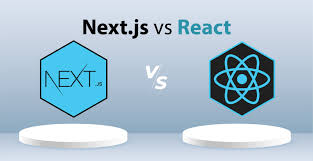Why Choose Next.js Over React: Key Advantages for Modern Web Development
 Arab Amer
Arab Amer
In today's fast-paced web development world, developers need speed, scalability, and SEO-friendliness — all without wasting hours in setup and configuration. While React is a powerful UI library, it lacks certain features out-of-the-box. That’s where Next.js becomes a game-changer.
React has revolutionized the way we build user interfaces with its component-based architecture and flexibility. However, when it comes to building production-ready applications with advanced features like routing, performance optimizations, and SEO, React alone might require additional configurations and boilerplate code.
That’s where Next.js steps in — a powerful React framework that enhances React’s capabilities, making it easier for developers to build fast, scalable, and SEO-friendly web applications out of the box.
Understanding the Connection: Next.js and React
At its core, Next.js is built on top of React. While React handles UI components and state management, Next.js provides the structure and additional features required to build complete web applications. Think of React as the engine and Next.js as the vehicle that makes the engine production-ready with advanced features baked in.
Key Advantages of Next.js Over Plain React:
1. Simplified Routing with File-Based System
Unlike React, where you need to manually configure routing (typically with libraries like React Router), Next.js offers automatic file-based routing:
pages/index.js→/pages/about.js→/aboutpages/blog/[slug].js→ Dynamic routes like/blog/:slug
This simple, intuitive routing system helps you avoid repetitive code and maintain a clean project structure.
2. Multiple Rendering Strategies
React primarily handles client-side rendering, but Next.js offers flexibility by supporting multiple rendering methods:
Server-Side Rendering (SSR): Generates HTML on each request, great for SEO and dynamic content.
Static Site Generation (SSG): Pre-renders pages at build time for ultra-fast performance.
Incremental Static Regeneration (ISR): Allows static pages to be updated after deployment without rebuilding the entire site.
Client-Side Rendering (CSR): Still available when dynamic client-side behavior is needed.
This flexibility allows you to choose the rendering method best suited for each page or component.
React vs. Next.js Comparison Table
| Feature | React | Next.js |
| Routing | Requires React Router | Built-in file-based routing |
| Rendering Options | Mostly CSR | CSR, SSR, SSG, ISR |
| Performance Optimizations | Manual setup | Built-in (Image, Fonts, Code-splitting) |
| API Routes | Not available | Built-in API routes |
| SEO-Friendly | Requires manual setup | Automatic with SSR and SSG |
Real-Life Use Cases
✅ Blogs or content-heavy sites: Use SSG or ISR for better SEO and faster load times.
✅ E-commerce websites: Leverage SSR for product pages with frequently changing inventory.
✅ Dashboards and internal tools: Use CSR where SEO isn’t a priority but dynamic interaction is.
✅ Marketing landing pages: Pre-generate with SSG for maximum speed and performance.
3. Built-In Performance Optimizations
Next.js includes powerful performance enhancements right out of the box, eliminating the need for manual setup:
Automatic code splitting: Load only what’s needed for each page.
Image optimization: The
next/imagecomponent serves responsive, optimized images.Font optimization: Prevents layout shifts and improves page stability.
Script loading strategies: Load third-party scripts efficiently with the
next/scriptcomponent.
These features collectively ensure that your application is fast, smooth, and user-friendly.
4. API Routes — Full-Stack Capabilities
Another standout feature of Next.js is the ability to create API routes directly in your application. This allows you to build backend logic without leaving the Next.js ecosystem:
jsCopyEdit// pages/api/data.js
export default function handler(req, res) {
res.status(200).json({ message: 'API route in Next.js' });
}
This feature transforms Next.js into a full-stack framework, allowing frontend and backend development to live in harmony within the same project.
FAQ: Next.js vs React
Q: Is Next.js faster than React?
A: Yes! Next.js has built-in optimizations like automatic code-splitting, SSR, and SSG that make it much faster for production.
Q: Can I use React without Next.js?
A: Absolutely, but for advanced production features, you’d need additional setup and third-party libraries.
Q: Is Next.js harder to learn than React?
A: Not really! If you know React, picking up Next.js is smooth, and it reduces setup headaches.
Conclusion
While React is an exceptional library for building UIs, Next.js transforms that experience by providing a complete framework with built-in routing, rendering strategies, performance optimizations, and API capabilities.
If you’re building a production-grade web application and want to focus on delivering value instead of configuring boilerplate, Next.js is the way to go.
👉 What do you prefer for your next project — React or Next.js? Drop your thoughts in the comments!
👉 Follow me for more web development insights and tutorials!
Subscribe to my newsletter
Read articles from Arab Amer directly inside your inbox. Subscribe to the newsletter, and don't miss out.
Written by

Arab Amer
Arab Amer
I'm a passionate Frontend and Java Developer with a strong focus on building modern, scalable web applications. Currently, I work at a startup, where I contribute to creating dynamic user experiences using Next.js and React.js. I love sharing my knowledge through blogs, helping developers learn and grow in the ever-evolving world of frontend development. Constantly exploring new technologies, I aim to blend performance, design, and functionality in every project I work on.